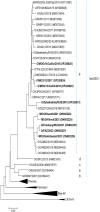Insights into the Molecular Epidemiology of Foot-and-Mouth Disease Virus in Russia, Kazakhstan, and Mongolia in Terms of O/ME-SA/Ind-2001e Sublineage Expansion
- PMID: 36992307
- PMCID: PMC10056362
- DOI: 10.3390/v15030598
Insights into the Molecular Epidemiology of Foot-and-Mouth Disease Virus in Russia, Kazakhstan, and Mongolia in Terms of O/ME-SA/Ind-2001e Sublineage Expansion
Abstract
Foot-and-mouth disease (FMD) has long been recognized as a highly contagious, transboundary disease of livestock incurring substantial losses and burdens to animal production and trade across Africa, the Middle East, and Asia. Due to the recent emergence of the O/ME-SA/Ind-2001 lineage globally contributing to the expansion of FMD, molecular epidemiological investigations help in tracing the evolution of foot-and-mouth disease virus (FMDV) across endemic and newly affected regions. In this work, our phylogenetic analysis reveals that the recent FMDV incursions in Russia, Mongolia, and Kazakhstan in 2021-2022 were due to the virus belonging to the O/ME-SA/Ind-2001e sublineage, belonging to the cluster from Cambodian FMDV isolates. The studied isolates varied by 1.0-4.0% at the VP1 nucleotide level. Vaccine matching tests indicated that the vaccination policy in the subregion should be tailored according to the peculiarities of the ongoing epidemiologic situation. The current vaccination should change from such vaccine strains as O1 Manisa (ME-SA), O no 2102/Zabaikalsky/2010 (O/ME-SA/Mya-98) (r1 = 0.05-0.28) to strains that most closely antigenically match the dominant lineage O No. 2212/Primorsky/2014 (O O/ME-SA//Mya-98) and O No. 2311/Zabaikalsky/2016 (O ME-SA/Ind-2001) (r1 = 0.66-1.0).
Keywords: VP1; epidemiology; evolution; foot-and-mouth disease.
Conflict of interest statement
The authors declare no competing interests. The authors declare that the research was conducted in the absence of any commercial relationships that could be construed as a potential conflict of interest.
Figures





References
-
- Singh C.P., Verma A.K., Pal B.C. Prevalence of protected animals against foot and mouth disease in Uttar Pradesh. Haryana Vet. 2008;47:107–109.
Publication types
MeSH terms
LinkOut - more resources
Full Text Sources

